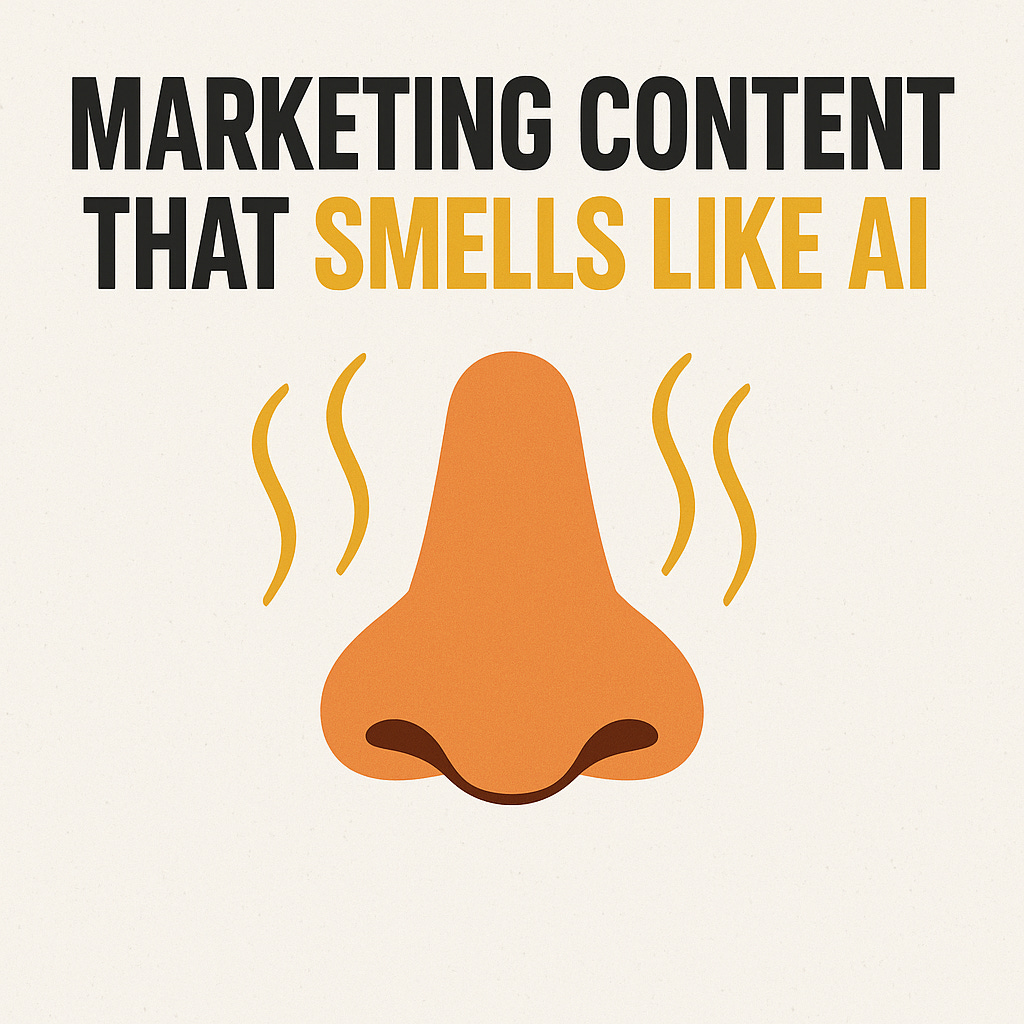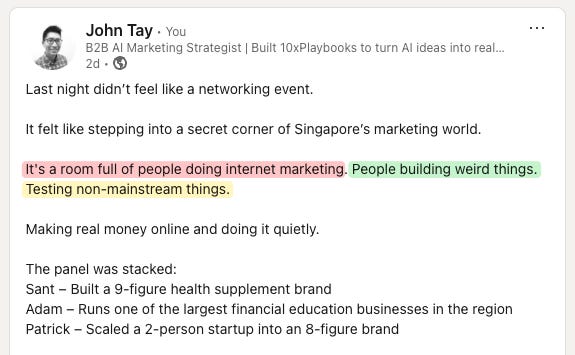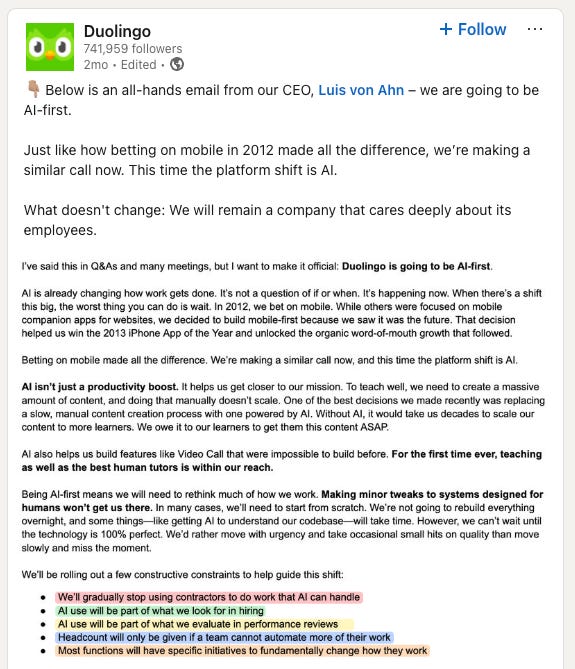Marketing Content That Smells Like AI: 9 Dead Giveaways
Once you spot them, you can’t unsee them.
It’s probably LinkedIn’s fault.
But after months of using AI and reading way too much content about AI, I am starting to become desensitised to anything written by it.
There’s a certain mechanical rhythm. A scent. A synthetic “something” you can’t quite name but you feel it.
So I did a deep dive. Reddit threads. AI Substacks. TikToks. Prompt engineering rabbit holes.
All to figure out what really gives AI-written content away.
So if you're using AI to write your marketing content… you know exactly what not to do.
I’m Not Here to Preach
I don’t think using AI to write is bad.
I use it too.
Especially if AI helps to express your points clearly, and saves you time in the process.
The issue is the it’s the patterns that it repeats. When used used sparingly, no one notices.
But when overused, your content starts to feel... mechanical.
This guide shows you what to avoid. So you still sound like you.
#1: Rule of 3
Pattern: Three short phrases in succession often with escalating emotion or impact.
Purpose: A common copywriting technique. Three points are often easier to remember and more convincing than just one or two.
Examples:
“We launched fast. We tested hard. We scaled what worked.”
“The message grabs attention. The story builds trust. The CTA seals the deal.”
Writing in threes doesn’t mean it’s an AI red flag. It’s the overuse of the Rule of 3 that leads to a certain “mechanical” feel in the content.
#2: Constrast Framing
Pattern: “That’s not just X — it’s Y.”
Purpose: Reframe a concept to change how the reader evaluates it.
Examples:
“It’s not just a scheduling tool — it’s your studio’s revenue engine.”
“It’s not about impressions — it’s about intent.”
I personally think this structure is magnetic writing because it flips perspective. It repositions the reader’s assumption and reframes the value in a single sentence.
But AI? Uses this too much. Way too much.
#3: Poetic Shift Phrases
Pattern: “That’s not just X — it’s Y.” (same form)
Purpose: Elevate the vibe to sound emotionally wise or profound.
Examples:
“Our brand story isn’t just messaging — it’s a movement.”
“This campaign isn’t just about reach — it’s about resonance.”
These poetic shift phrases sounds deep, but rarely says much. I think AI leans on this to fake emotional weight.
#4: Odd Numbered Structures
Pattern: Lists, phrases, or frameworks built around odd numbers (especially 3, 5, and 7).
Purpose: Odd-numbered groupings are naturally more rhythmic and easier to process.
Examples:
#5: Hypophora
Pattern: A question immediately followed by the answer.
Purpose: To control the flow of attention. First by asking a question the reader might be thinking, then answering it immediately to appear confident or persuasive.
Examples:
“Why does this matter? Because your content needs to earn attention, not just borrow it.”
“How do we solve this? With fewer steps and clearer value.”
After a while, it makes me feel like every paragraph starts to feel like a scripted Q&A.
#6: Adverbs (Sometimes)
Pattern: Use of words like actually, truly, deeply, carefully — often stacked before verbs or adjectives to add “emotional depth.”
Purpose: To make a sentence sound more thoughtful or polished.
Examples:
“This tool is incredibly useful for busy marketers.”
“We truly believe in creating deeply human experiences.”
AI tends to front-load adverbs or stack them awkwardly, creating that uncanny “LinkedIn poetry” rhythm. Humans just don’t use them these words mechanically.
#7: Marketing Cliché Pairings
Pattern: Two values or outcomes, often opposites or complements, paired into a tidy and rhythmic phrase.
Purpose: To sound punchy and balanced by mimicking smart-sounding brand language or tagline rhythm.
Examples:
“Simple to use. Hard to ignore.”
“Low lift. Big results.”
“Fast to build. Built to last.”
#8: Scripted Transitions
Pattern: Phrases like “Let’s unpack this…” or “Here’s what that really means” which are used to shift tone into a fake-reflective mode.
Purpose: To signal depth or analysis, usually before breaking down a concept
Examples:
“Let’s unpack this idea for a second.”
“Here’s what that really means for your business.”
“But what’s the bigger picture here?”
“Let that sink in.”
#9: Paragraphs That End in Vibes
Pattern: Starts with a business challenge or observation, ends with a vague, soft “insight” that feels emotionally satisfying but says nothing concrete.
Purpose: To mimic reflection, close loops, and sound thoughtful
Examples:
“We didn’t just need a new strategy. We needed a new mindset.”
“That’s the shift. From output to outcomes.”
“The solution wasn’t in the data — it was in the clarity we found along the way.”
“And maybe… that’s what real leadership looks like.”
Wrap Up:
Please don’t just paste this article into ChatGPT and say, “Write my content but avoid all these.”
That’s how you end up with something technically fine, but still lifeless.
Use AI if it helps. But edit like a human.
I test AI workflows on real marketing problems.
And turn the useful ones into 10x Playbooks.
So business owners and solo marketers doing it all themselves can skip the guesswork… and copy what actually works.
→ I drop one of these 10xPlaybooks 🚀 every week, don’t miss the next.
John



